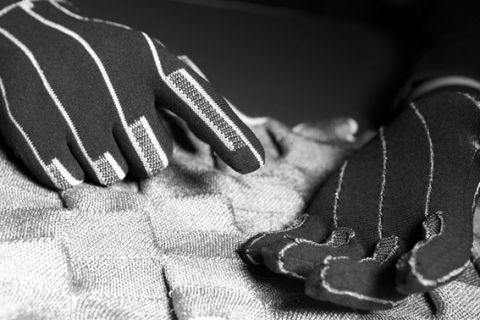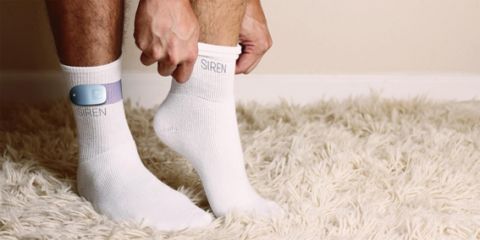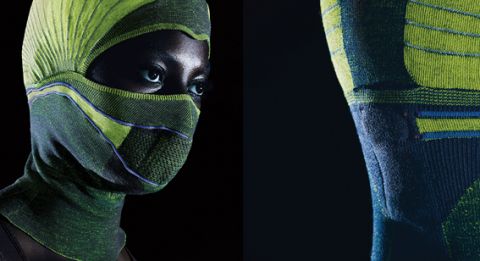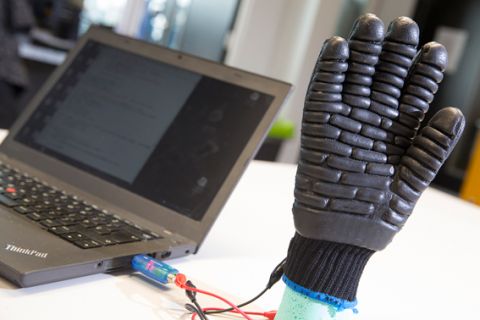 Deborah Maxwell, an Associate Patent Attorney, believes that intellectual property is one of a business’ most valuable assets and so deserves to be protected carefully.
Deborah Maxwell, an Associate Patent Attorney, believes that intellectual property is one of a business’ most valuable assets and so deserves to be protected carefully.It is hard to imagine that you would deliberately leave the entrance to your business premises wide open each night, constantly exposing valuable assets to theft, yet that is exactly what many textiles companies are doing every day by failing to protect their most creative products and processes.
Responding to price-based competition from low-cost manufacturing hubs in Asia, during the past 20–30 years the textiles industry in the higher-wage economies has focused its attention on developing innovative techniques to bring breakthrough products to market.
From creating lightweight and durable fabrics, through to more effective ways of dying yarns and joining fabrics, these businesses have played a pivotal role in driving the sector forward. However, some businesses are so focused on maintaining a competitive edge, they are failing to realize the full commercial benefit of their ideas, with many falling at the first hurdle in not even recognizing that their innovations can be protected.
Intellectual property (IP), which refers to creations of the mind, including inventions and designs, as well as symbols, names and images used in branding, is often the greatest asset within a business. In addition, all the elements of IP can be protected by laws that enable individuals and companies to earn recognition and, potentially, financial benefit from their inventions and creations.
What sort of protection?
Depending on the nature of an innovation, the four main types of IP protection are patents, design rights, trademarks and copyright. Some innovations can be protected using all four, which creates an extremely powerful and valuable business asset.
Protection for products, processes and application
Patents are designed to provide protection for products, as well as how the products are made and used, with emphasis on the way in which the product or method functions. W.L. Gore and Associates of Newark, Delaware, USA, uses patents, for instance, to protect its highly innovative expanded polytetrafluoroethylene (ePTFE) fabric (Gore-Tex®) and the associated methods of manufacturing.
 Gloves, socks and headgear are just some of the smart textile garments that are being developed at the UK’s Nottingham Trent University using a flexible, washable yarn embedded with microelectronic devices. However, by applying for a carefully prepared patent that does not limit the underlying concept to any one application, the University is able to license its intellectual property, once granted, to companies in different sectors. Further examples of products based on Nottingham Trent University's smart textiles follow in the images below.
Gloves, socks and headgear are just some of the smart textile garments that are being developed at the UK’s Nottingham Trent University using a flexible, washable yarn embedded with microelectronic devices. However, by applying for a carefully prepared patent that does not limit the underlying concept to any one application, the University is able to license its intellectual property, once granted, to companies in different sectors. Further examples of products based on Nottingham Trent University's smart textiles follow in the images below.Many innovative ideas originate from solving an existing problem or improving the experience of the end-user, which often results in a truly novel product. In the textile sector, this might be a new garment component that provides better comfort for the wearer, has technical characteristics suited for a specialized environment or improves the lifespan of a garment. By obtaining protection for such innovations, a business can prevent competitors from implementing the improvement with its associated advantages and thereby stealing market share for up to 20 years, the maximum term for a patent.
While new, innovative products are obvious candidates, improvements and modifications to existing products or methods of manufacture are also potentially suitable for patent protection. Businesses, particularly those in the manufacturing sector, often lose out on protecting such developments because they are unaware that they have a patent-worthy invention. Some indicators that patent protection might be available include modifications/improvements aimed at, for instance, improving the efficiency of a manufacturing method or reducing the cost or environmental impact of running a production line. Unlikely areas in which manufacturing-related patents have been considered useful from a commercial perspective include carpet weaving (particularly improvements in the associated machinery), lingerie (such as improvements in methods for creating moulded bras) and the joining of fabrics (for instance, to improve comfort or facilitate stretch).

The keys to successful patenting are to file early and to keep details of the invention confidential prior to filing. Once the applicant has a proof-of-concept (an understanding of the components that allow the underlying idea to work, which does not have to include every single detail of the final product), it is important to seek advice from an IP expert who can help get a patent application on file. Once filed, the applicant is free to commercialize the product or process (so long as the details that are commercialized are included in the application), which can help to fund the IP protection process. Applicants also benefit from a period after filing in which to refine an invention ready for launch, safe in the knowledge that the application will not be published for 18 months.
Protection for designs
Design rights provide protection for the appearance of the whole or part of a product, including its shape, surface decoration and texture. Consequently, as well as investing in patent protection, many of the garments and footwear that include Gore-Tex® fabric, for instance, are protected by registered designs.
Design rights are particularly useful in fast-moving sectors, such as fashion, as they can exist automatically as “unregistered design rights”. However, rights can also be registered, which gives the owner protection for longer—up to 25 years in the UK and European Union (EU), compared with typically ten years, and three years, respectively, for unregistered designs. Another key difference is that for unregistered rights, owners must be able to prove that the infringing party copied the design, rather than created one independently that happens to be the same or similar, whereas with registered designs they do not. This usually makes unregistered design rights significantly more difficult and costly to enforce.
The right time to seek registered design protection is when you know exactly what the end-product or surface decoration will look like, which, unlike the procedure described above for patents, might be much nearer the end of the design process. In the EU, for instance, registered design protection can be established quickly and at a relatively low cost. There are also considerable cost-savings to be made if multiple designs are filed at the same time, such as for a collection of garments. Once filed there are usually no additional costs for obtaining protection in the EU, and protection is granted for five years. After this period, the owner can decide whether it makes commercial sense to invest further and renew the design registrations for a further five years, up to a maximum of 25 years in total.
Protection for names and logos
Trademarks provide protection for names and logos used to identify a business, its products and services. Continuing with the W.L. Gore example, the phrase “GORE-TEX” is a registered trademark owned by W.L. Gore & Associates Inc, for instance, together with various logos created for the Gore-Tex® brand. The company has been able to obtain revenue by licensing its well-known brand to other clothing manufacturers, who in turn seek to gain sales owing to the reputation consumers associate with Gore-Tex®-branded products.
When choosing a trademark, you should first consider whether the mark is distinctive. This means that the mark is not commonplace, generic or descriptive for the goods/services that you want to protect. Then you should conduct clearance searches to establish if the mark is available for registration and, crucially, whether your use of the mark will infringe somebody else’s rights. If it is not available, then choose another mark, as it does not make sense to invest in a mark that cannot be used or protected.
When you have your mark, register it as soon as possible. Once the mark is registered you will be able to prevent others from using an identical or confusingly similar one for identical/similar goods and services. Simply being on the trademark register is a deterrent and discourages others from using or registering a similar mark.

Registration is not cheap, but it is less than the cost of preparing evidence to substantiate unregistered rights, which is the only alternative. In addition, it will often be necessary to disclose sensitive business information, such as sales volumes, turnover and advertising expenditure in order to prove that you have unregistered rights in the mark.
A final consideration is overseas protection. Trademarks are a territorial right, which means if you want to prevent a third party copying your trademark in a country then you must have a registration in that country. Unlike in the UK, many countries work on a so-called “first-to-file” basis and, therefore, there are limited rights (if any) in unregistered marks. There have been numerous examples, particularly in China, of companies being sued for trademark infringement, for the use of their own unregistered trademarks, where a third party has opportunistically registered an identical mark for identical goods.
Protecting literary, artistic and musical works
Copyright provides protection for the originator or author of a literary, artistic or musical work. Examples could include sketches of the various Gore-Tex® garments, W.L. Gore’s website and even the wording of the washing instructions supplied with its garments. Copyright protects the expression of an idea and not the idea itself; for instance, copyright would protect a software code, but not the function/output of the code. Even in countries where there is no official register for copyright, including the UK, it is a good idea to use the copyright symbol “©” to notify third parties of your rights in a work.
Why protect intellectual property?
The successful commercialization of a product or service is often preceded by a considerable investment in research and development (R&D). R&D costs are not purely financial, but also include a substantial investment of human resources. In addition, significant marketing costs may be incurred to establish and maintain a good reputation for the product or service.
Failure to protect a company’s IP rights may allow competitors to freely exploit these investments, potentially giving them a significant commercial advantage.
A significant area of research for the textile sector presently is in conductive textiles. Researchers at the Cambridge Graphene Centre at the University of Cambridge, UK, together with colleagues from Jiangnan University in China, for instance, have pioneered a method of producing conductive cotton using graphene-based inks. Such research has the potential to make a transformational impact, providing endless applications in wearable electronics.
Assuming the University of Cambridge has applied for patent protection of its unique method, as it has done with several other conductive textile-related inventions, it can stop competitors from stealing its ideas or otherwise taking an unfair advantage of the extensive R&D that no doubt went into the idea. In this regard, once granted, a patent gives the owner a period of monopoly during which its innovation is protected in several ways.
For a UK patent relating to a product, for instance, competitors are prevented from making, selling (or offering to sell), using, importing or even keeping the product in the UK. For patented processes, competitors cannot use or offer for use the process, nor can they sell, offer for sale, use, import or keep any of the products that are obtained directly from the process. (Precise details of the law vary from country to county, but broadly the principles are the same.)
Like physical assets, IP can be bought and sold, and used to attract and secure finance. In addition, IP rights can be licensed to other parties, either as a whole or in part. As such, IP rights can be a valuable means of generating income and/or securing investment, particularly for small and medium enterprises (SMEs). Even if you decide not to obtain registered IP rights for your creation, you must consider whether your proposed commercial activity could infringe a third party’s IP right. It is important to carry out searches of registered IP, such as existing patents, to see whether you are free to exploit your invention, and an IP specialist can help you do this.
What is the cost of protection?
Securing IP rights can seem to be a costly exercise, especially for SMEs, but should not be dismissed without fully understanding the potential for commercial gain. Other considerations need to be weighed before making final decisions too, including:
- the nature of the protection—sometimes a patent is not the most suitable form, because the cost to secure protection across all relevant markets is not justified by the projected sales of the invention;
- in fast-moving sectors, such as technical textiles, it may be more appropriate to develop products continually while keeping details confidential for as long as possible to gain and maintain a market-leading position;
- sometimes, the appearance of the product, while unique, is not the most important part of the innovation, but the owner believes that the brand will be long-lasting and attract repeated sales.
IP specialists can guide you through this process so you get the best protection for your budget, but it is important they are consulted as early as possible in the process.
In the case of a core innovation intended for use throughout a wide product range, however, patent protection is almost always essential for obtaining the best commercial gains. The UK’s Nottingham Trent University, for instance, has secured UK patent protection and is seeking patent protection in nine territories worldwide for its research into electronic textiles, which it believes has significant potential in the health, sports, defence and fashion sectors(2). The patent protects a yarn with microelectronic devices embedded in it. The yarn is intended for use in the manufacture of smart garments, and is flexible and machine-washable, two considerations in this field.

The full range of applications in which such a yarn can be used is extensive; however, because a patent can be prepared carefully to not limit an underlying concept to a particular application, Nottingham Trent University has the potential to license the patents, once granted, to companies in different sectors, gaining the maximum financial benefit from its innovation. This example clearly underlines the commercial potential of a patent when such a wide range of applications are possible.
Necessary steps
IP can have a transformational impact on the success of a business so it is vital that organizations understand the value of their ideas and take the necessary steps to put adequate protection in place. When working on a new project, they should always keep in mind the scale of R&D that they have invested and the degree to which competitors might wish to copy the idea.
It is worth them spending time analysing each project to see if they have created an asset worth protecting. Have they solved an existing problem in a new way? Does the product have a unique appearance? Do they want customers to invest in a brand? If the answer to these questions is yes, then it is time to find out how they can best protect their ideas. Failure to do so leaves the door wide open for their competitors.
The author
Deborah’s next article looks at how managing and protecting IP in the correct way can drive innovation.

Deborah Maxwell is an Associate Patent Attorney at Potter Clarkson, one of the largest full-service intellectual property firms in Europe. Bringing together the collective expertise of more than 150 staff (including over 60 attorneys, solicitors and paralegals), the firm has offices in: Nottingham, UK; Munich, Germany; Stockholm and Lund, Sweden.
Established more than 125 years ago in Nottingham, a city that was at the forefront of lacemaking, the firm’s roots are firmly embedded in the textiles sector. Today, the firm’s specialist fashion and textiles team works with businesses of all sizes from innovative start-ups through to established brands such as Wonderbra, Triumph and Stretchline.
